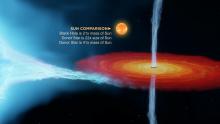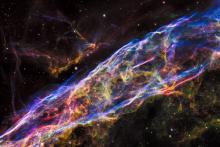Listen to today's episode of StarDate on the web the same day it airs in high-quality streaming audio without any extra ads or announcements. Choose a $8 one-month pass, or listen every day for a year for just $30.
You are here
Cygnus
One of the most graceful and beautiful of all constellations soars high overhead on summer nights. Cygnus, the swan, lines up in the east and northeast in early evening. The swan’s body is roughly parallel to the horizon, with its wings extended above and below. The bright star Deneb marks its tail, with the double star Albireo representing its beak.
Cygnus is also known as the Northern Cross. In fact, the pattern is so bright and obvious that quite a few cultures have shown it as a cross.
For the Maya of Central America, the cross may have played a role in the succession of kings.
Evidence of this role comes from a temple in the Mayan city of Palenque. Murals in the temple depict starry crosses, which some scientists have interpreted as Cygnus. The temple is aligned toward the northwest, to the point on the horizon where Deneb set.
Some of the artwork depicts the life of King Chan Bahlum. He was appointed heir to the throne in June of the year 641. From Palenque, Deneb was rising around sunset at that time of year. And Chan Bahlum became king in January of 684 — a time when Deneb was just becoming visible in the morning sky, and dropping from view at dusk — in perfect view from the temple.
Look for Deneb and the rest of Cygnus throughout the night. The swan is in the east and northeast as darkness falls, with its body roughly parallel to the horizon. It flies high overhead during the night.
More about Deneb tomorrow.
Script by Damond Benningfield





